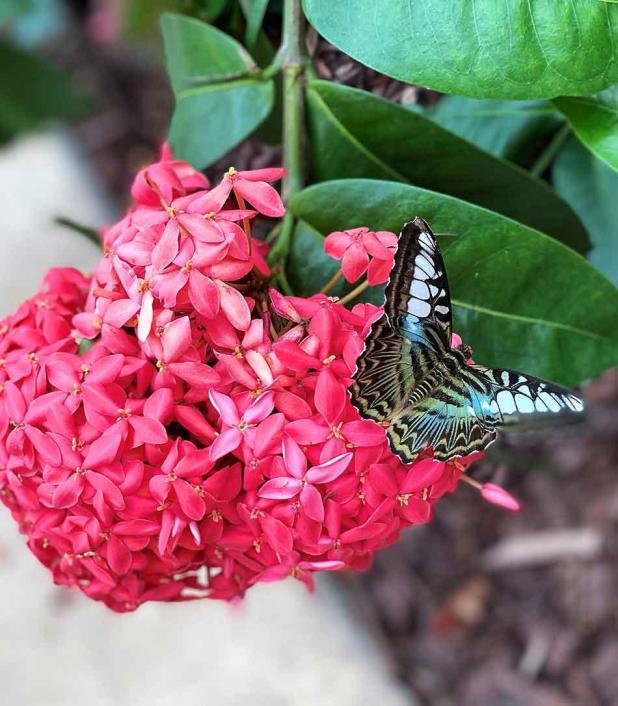
Butterfly on ixora.
—LSU AgCenter/Heather Kirk-Ballard
Get It Growing: Protect and promote pollinators
June 21-27 is National Pollinator Week, and the focus is “Pollinators, Plants, People, Planet,” according to www.pollinator.org.
Protecting pollinators should be popular year-round, but in June, we aim our focus on how these beneficial creatures help our ecosystems and bring food to our tables.
According to the National Wildlife Federation, pollinators are responsible for one of every three bites of food that we take. One great way to help pollinators is by planting native and non-invasive plants that produce both pollen and nectar to attract not just bees and butterflies, but also hummingbirds, small mammals, bats, small birds and many other animal species. There are hundreds of thousands of species of animal pollinators.
You can help provide habitat for pollinators in your lawn, gardens and anywhere you grow plants outdoors. You can create a pollinator-friendly habitat by planting native plants, but you can also use cultivated ornamentals. Try using ones that are not very aggressive or spread too easily.
Heirloom flower varieties are great additions to a pollinator-friendly habitat. Look for seeds in local retail garden centers and online that feature the word “heirloom” in their description. Plant breeding has improved plants’ resistance to disease and insect pests and allowed for larger blooms and fruit. This process has also caused some plants to lose their fragrance, nectar and pollen that attracts and feeds pollinators.
Be sure to incorporate a wide variety of plants that provide diversity for the pollinators to choose from, and design the garden so that there is a continuous succession of colorful, blooming flowers from spring to fall. Choose bright flowers that attract pollinators to your garden.
Also, provide water for bees, butterflies and other insects — make sure you don’t provide too much and create a breeding ground for mosquitos. You can use a shallow dish or plant saucer of water and refill it daily.
Of course, avoid the use of pesticides or eliminate their use all together. If you must use them, apply them at night when most pollinators are not active. The Pollinator Part-nership has created a virtual toolkit to help you with your projects at www.pollinator.org/polli nator-week.
There are many flowering annuals and perennials that you can incorporate into your garden to attract pollinators. Here is a list of great pollinator plant selections: amaranthus, asters, bee balm, bachelor’s buttons, black-eyed Susans, calendulas, cleome, coneflowers, cosmos, coreopsis, columbine, delphinium, gaillardia, guara, lantana, lavender, marigolds, morning glory, nasturtium, salvias, sunflowers, sweet alyssum, sweet peas, verbena, yarrow and zinnias. Don’t forget vegetable plant flowers!
You can also incorporate flowering shrubs such as abelia, American beautyberry, buttonbush, butterfly bush, blueberries, hydrangeas, roses, rose of Sharon, rose mallows and viburnums.
Flowering trees that attract pollinators are camellias, crape myrtles, eastern red bud, fruit trees, hawthorns, tulip trees, magnolias and vitex.
Be sure to plant annuals in the right season, and remember that plants vary in their growing conditions. Some species of plants that do well in wet areas are blue stars (Amsonia spp), milkweed, crinum lillies, hibiscus, spider lilies (Hymenocallis spp), Louisiana irises and rushes (Juncus spp.). Other native shrubs such as buttonbush (Cephala-nthus occidentalis), ‘Henry’s Garnet’ Virginia sweetspire (Itea virginica) and rose mallows (Hibiscus moscheutos) do well in wet areas.
American beautyberry (Callicarpa americana) is another great native shrub, but it prefers good drainage. Sunflowers, yaupon hollies, sages, salvias, bergamots, coreopsis, compass plants and black-eyed Susans are more drought tolerant.
You can help native pollinators by dedicating a portion of your landscape to native plants. Natives survive with little to no inputs, all while supporting native pollinators.
The good news is that every plant counts, and even small actions by individuals can help. You can use the suggestions here or visit the Lady Bird Johnson Wildflower Center at wildflower.org and choose the “Native Plants” tab to find flowers that will work in your USDA hardiness zone.
